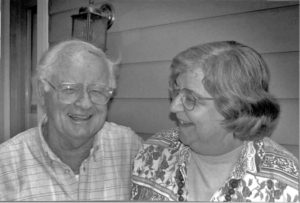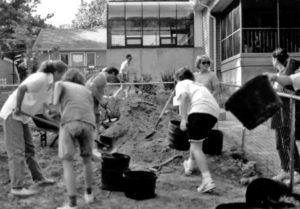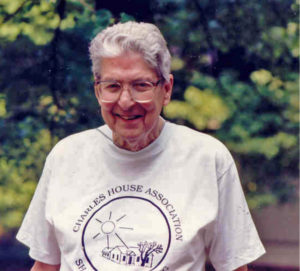Founding Executive Director Bettie Bradford shared this about the origins of Charles House:
 In 1981 my father, Charles Jones, who was seventy-five at the time, began having difficulty sleeping. Doctors attributed his problems to various causes ranging from indigestion to depression and prescribed a variety of pills to cure him. None of them helped. In fact, he became progressively worse. Over time, the continuing loss of sleep and the medication side effects took their toll on him both physically and mentally. He began to experience short term memory loss. His ability to concentrate was impaired, making it impossible for him to read or write. Soon he was no longer physically able to pursue his hobbies of woodworking, gardening, macramé, or rug hooking. It was not safe to leave him home alone in the daytime or unattended at night because he dearly loved hot chocolate and would turn on the stove, sit down to wait for the milk to heat, and drift off to sleep.
In 1981 my father, Charles Jones, who was seventy-five at the time, began having difficulty sleeping. Doctors attributed his problems to various causes ranging from indigestion to depression and prescribed a variety of pills to cure him. None of them helped. In fact, he became progressively worse. Over time, the continuing loss of sleep and the medication side effects took their toll on him both physically and mentally. He began to experience short term memory loss. His ability to concentrate was impaired, making it impossible for him to read or write. Soon he was no longer physically able to pursue his hobbies of woodworking, gardening, macramé, or rug hooking. It was not safe to leave him home alone in the daytime or unattended at night because he dearly loved hot chocolate and would turn on the stove, sit down to wait for the milk to heat, and drift off to sleep.
 Fortunately, we were a family of four. My parents had built an apartment onto their home to use as a base from which to take extended trips to their cabin in the mountains and to visit family and friends in Florida, California, and Europe. My husband, Roy, and I were living in the “big” side of the house. We both worked full-time jobs in Raleigh. Mother cared for Dad during the day. We assumed his care when we returned home from work. Many nights it was necessary for us to sleep in shifts, taking turns sitting up with him. Twice I had to take several months leave without pay from my job to help with his care.
Fortunately, we were a family of four. My parents had built an apartment onto their home to use as a base from which to take extended trips to their cabin in the mountains and to visit family and friends in Florida, California, and Europe. My husband, Roy, and I were living in the “big” side of the house. We both worked full-time jobs in Raleigh. Mother cared for Dad during the day. We assumed his care when we returned home from work. Many nights it was necessary for us to sleep in shifts, taking turns sitting up with him. Twice I had to take several months leave without pay from my job to help with his care.
We never stopped trying to find the cause of his sleeplessness. Finally, in October of 1984 it was determined by specialists at the Sleep-Wake Disorders Center of the Albert Einstein College of Medicine at Montefiore Hospital in New York City that he had a sleep disorder called nocturnal myoclonus. The prescription medications he had been taking had only been aggravating the condition. Unfortunately, there was no known treatment for this illness. It was a condition which my father and we, his family, would have to learn to live with. Once Dad became medication free he did improve. He was far from well but his symptoms of mental illness disappeared. He still could not sleep, read, write, drive, or independently pursue hobbies.
Even before the discovery of the cause of Dad’s illness, it was clear we needed help in caring for him. Mother couldnot be with him day and night and Roy and I needed to continue working. A nursing home was not considered since there we knew his

sleeplessness and night wanderings would be “managed” with medication and/or restraints. Mother felt she could take care of him during the night if she could have the days to rest and manage their affairs. We needed a place for him to spend his weekdays. A local nursing home offered a small day program at their facility. Dad did not want to go, but at our insistence he did. It soon became clear that the activities program they offered was minimal and not suitable for him and he positively hated going to a nursing home every day. After that, we tried a private daytime care center in Durham for a short while. We found it to be understaffed and participants did a lot of just sitting. Dad strongly objected to the lack of attention given to some of the participants and became frightened of being restrained on one occasion.
It was at this point the idea of starting an adult daytime care center first occurred to me. Dad needed a place that was homelike and pleasant where he would be treated with respect at all times and afforded the opportunity to make some choices. There needed to be enough qualified staff to assure his safety and to provide purposeful activities which he would find engaging and stimulating and which would encourage interaction with others.
 I talked with local professionals in the field of aging, visited several successful adult daycare centers in different parts of the state, attended statewide adult daycare conferences, and met with Department of Social Service personnel about certification requirements. Everyone spoke to the need for such programs and encouraged me. Realizing there would be significant start-up costs involved and, once operational, some people who might need the care would not be able to pay for it, I also contacted 100 longtime friends of my father to see if they would be willing to give their financial support to such a non-profit venture. Their response was overwhelmingly positive. The rest is history.
I talked with local professionals in the field of aging, visited several successful adult daycare centers in different parts of the state, attended statewide adult daycare conferences, and met with Department of Social Service personnel about certification requirements. Everyone spoke to the need for such programs and encouraged me. Realizing there would be significant start-up costs involved and, once operational, some people who might need the care would not be able to pay for it, I also contacted 100 longtime friends of my father to see if they would be willing to give their financial support to such a non-profit venture. Their response was overwhelmingly positive. The rest is history.
We decided to name the daytime program for my father; first, because his needs had inspired it and second because his longtime friends’ generosity made it possible. We decided to call our center Charles House. Charles House Association was incorporated as a 501(c)3 organization in March of 1984. The Hillcrest Street property in Carrboro was purchased in 1987. In 1987 enough money had been raised to undertake the necessary renovations to the existing house.
Charles House opened in June 1990 with four staff members and four participants.
A recent biography of Charles Jones is Faith, Grace, and Heresy by Mark Pryor (Writer’s Showcase, 2002).
Bettie “Beppie” Bradford continued to lead Charles House through the time of Charlie’s death in 1994.
She and her family continued supporting the growth of Charles House. She died in November 2017.
